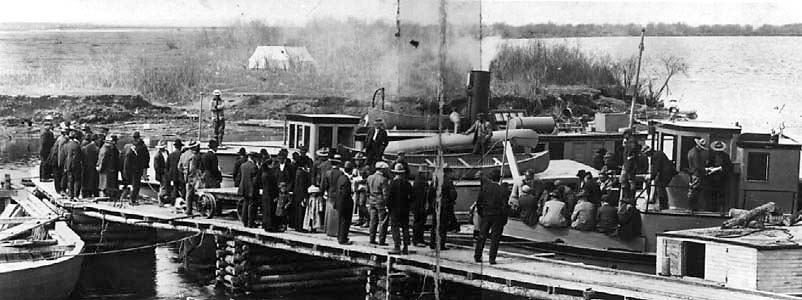Search | Image Archive | Reference | Communities | POV | Lesson Plans | Credits
 The town of The Pas was incorporated in 1912, but had been an important centre for centuries before that. Paskoyak, the name the Cree applied to the confluence of the Saskatchewan and Pasquia rivers was an important meeting place. Groups met there regularly to engage in trade and diplomacy.
The town of The Pas was incorporated in 1912, but had been an important centre for centuries before that. Paskoyak, the name the Cree applied to the confluence of the Saskatchewan and Pasquia rivers was an important meeting place. Groups met there regularly to engage in trade and diplomacy.
In the middle of the eighteenth century, when Europeans were establishing a fur trade in the area, Paskoyak was a natural location for a trading post. This first post was established by LaVerendrye in 1750, and was followed by a succession, mostly owned by small independent traders, or "pedlars" who established inland posts to compete with the Hudson's Bay Company.
The HBC never established a post at The Pas in the early years of the fur trade, situating its regional post instead at Cumberland House. In 1856, the HBC did finally establish Fort Defiance at the future location of the Pas, and in the 1870s, it became a commercial centre when the Company took advantage of the deep water and natural harbour on the Saskatchewan River to establish a steamship port from which it supplied the growing number of settlements along the river.
By the 1880s, talk had begun about a railway to the Hudson Bay, and it became a subject for much political debate and manoeuvring. Construction of what was later to be the Hudson Bay Railway was delayed until 1908, when the growing lumber industry generated enough commerce to warrant the construction of a line to The Pas from the Canadian Northern main line.
From 1908 on, The Pas was to be an important transportation link between the southern Manitoba and the North. After the boundary revisions of 1912, when the North became a part of Manitoba, there was a renewed interest in the region, not just as a source of furs, but as a source of timber, fish and minerals and precious metals. The opening of the first copper mine near Flin Flon in 1917 secured The Pas' place as the "Gateway to the North." It became the headquarters of northern mining transportation and exploration.
With access to the railway, The Pas became and important trans-shipment point, and a half a dozen steamships plied the waters of the Saskatchewan River between 1912 and the mid-1920s, linking aboriginal communities, mines and lumber camps to the commercial centres of the south.
Boosters of The Pas declared it to be "The Gateway to the Great Northland," and in 1916, the Provincial government created a special Commissioner for Northern Manitoba. The province constructed a courthouse, jail and Central School there that would meet the secondary school needs of the whole north.
In addition to serving as a conduit for commercial expansion, The Pas continued to be an important centre for the institutional interaction between aboriginal and European cultures. When the Canadian government purchased the townsite The Pas band in 1876, its members moved across the river, but remained in the area. There had been an Anglican Mission in the area since the 1840s, and in 1911, The Pas became the seat of the Catholic Bishop of Keewatin. In 1912, Les Soeurs Grises de Montré:al established a convent at The Pas which would act as a centre for their missionary, teaching and health care work in the North.
For many aboriginal people, visits to The Pas represented their first and sometimes only encounter with a European town, whether it was for trade, health care, education or spiritual training.
TimeLinks Characters: Janós Sikler is a labourer from Hungary is living in The Pas.
Page revised: 29 August 2009